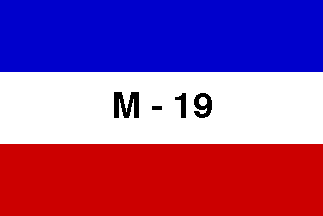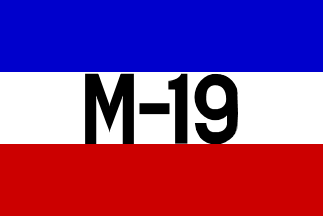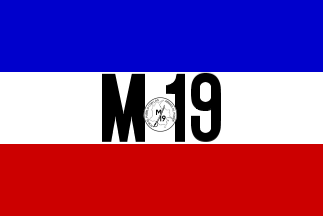
based on Encyclopaedia Universalis
image by Ivan Sache, 10 December 1998

Last modified: 2024-07-06 by daniel rentería
Keywords: colombia | m-19 movement |
Links: FOTW homepage |
search |
disclaimer and copyright |
write us |
mirrors
 image by Ivan Sache, 10 December 1998
image by Ivan Sache, 10 December 1998 See also:

based on Encyclopaedia Universalis
image by Ivan Sache, 10 December 1998

based on photo at SEMANA Magazine
image by Eugene Ipavec and Ivan Sache, 28 August 2005

based on photo (see below)
image by Eugene Ipavec and Ivan Sache, 28 August 2005

variant from the '90s
image from Semana on Youtube
.gif)
logo
image by Eugene Ipavec, 28 August 2005
Vertically divided blue/white/red, with M-19 in black in the white stripe.
Source: Photography of the funerals of the murdered past-leader of M-19
Carlos Pizarro, flag over the coffin. (Encyclopaedia Universalis, Yearbook 1991,
p. 40).
Ivan Sache, 10 December 1998
According to Courrier International #711, 17 June 2004, M19 is the 19
April Movement, founded on 19 April 1970, mostly by students. The M19 entered
the armed struggle against the Columbian government in 1973. On 6 November 1985,
the M19 seized the Court of Justice in Bogota. The seizure ended in a bloodbath
when the tanks of the Columbian army attacked the Court. In 1989, the M19
abandoned the armed struggle and joined the political legal life. His leader was
murdered when candidate to the Presidential election in 1990.
Ivan Sache, 27 December 2004
Here is a photo of Additional flag
(variant with a logo showing a map of Colombia with the sword of Colombia's
liberator Simon Bolivar and with the motto "Por el pueblo con las / armas al
poder" (For the people with the / arms to power). Also here is a photo from SEMANA
Magazine of a variant with different letter styles.
E.R., 23 March and 17 June 2005
Information taken from www.country-data.com:
"The 19th of April Movement (Movimiento 19 de Abril--M-19) traces its origins to
the allegedly fraudulent presidential elections of April 19, 1970, in which the
populist party of former military dictator Rojas Pinilla, the National Popular
Alliance (Alianza Nacional Popular--Anapo), was denied an electoral victory (see
Opposition to the National Front , ch. 1). Although Anapo--which was
subsequently led by Rojas Pinilla's daughter, María Eugenia Rojas de Moreno
Díaz, following the dictator's death in 1975--denied all links with the M-19,
the organization proclaimed itself to be the armed branch of the party. During
the early 1970s, Carlos Toledo Plata and Jaime Bateman Cayón distinguished
themselves as the M-19's principal leaders and ideologues. Toledo, a physician,
was an Anapo representative in Congress. Bateman served as the M-19's principal
commander for military operations. Both these men died during the 1980s--Toledo
in a shooting by two men believed linked to the MAS and Bateman in an airplane
crash. By mid-1988 Carlos Pizarro León-Gómez had emerged as one of the group's
principal decision makers.
The M-19's ideological orientation was a mixture of populism and nationalistic
revolutionary socialism. This orientation often led the group to seek political
support from Nicaragua and Cuba, but the M-19's leadership also claimed that it
resisted forming permanent foreign ties.
By mid-1985, when the number of active members was estimated at between 1,500
and 2,000, the M-19 had become the second largest guerrilla group in Colombia.
According to the IISS, the size of the M-19 in 1987 was estimated at 1,500
militants. A member of the Barco administration who was in charge of the
government's peace efforts, however, calculated that the organization had only
500 armed militants nationwide. By the mid-1980s, the M-19 had eclipsed all
other guerrilla organizations in urban operations. The M-19 reportedly
established columns (units) in each of Colombia's major cities. These columns
were in turn organized into independent cells.
Although the M-19's early operations, begun in 1972, were limited to bank
robberies, it quickly gained national attention through the 1974 theft of Simón
Bolívar's sword and spurs from the exhibit in the liberator's villa. Two years
later, the group kidnapped and subsequently murdered a Colombian trade union
official the M-19 accused of having ties to the United States Central
Intelligence Agency. In 1977 the M-19 began a campaign of economic sabotage. The
following year, government offices and police stations became the targets of
numerous attacks. In addition, the offices and representatives of United
States-based multinational corporations were repeatedly targeted in an effort to
drive the foreign interests from the country. Kidnappings of prominent
individuals continued, some of which resulted in the deaths of the abductees. In
1980 the seizure and occupation, for sixty-one days, of the Dominican Republic's
Bogotá embassy gained the group international attention.
The M-19's increasingly bold activities, coupled with evidence of Cuban training
and logistical support, prompted a hardening in the policies of the Turbay
administration during its final year in office. In 1982, however, the newly
installed Betancur administration offered political amnesty in exchange for the
M-19's agreement to a cease-fire. In July 1984, government officials and
guerrilla leaders signed a cease-fire agreement at Corinto in Cauca Department.
By late 1985, however, the accord unraveled. Charging the government with, among
other things, a systematic violation of the truce provisions and failure to
implement key political reforms that were part of the cease-fire agreement, the
M-19 returned to armed struggle. In October 1985, guerrillas wounded
then-Commanding General of the Army Samudio. By far the most spectacular
operation of the M-19 came the following month, when commandos seized the Palace
of Justice in Bogotá. The ensuing battle between the M-19 and the military left
over 100 dead, including 11 Supreme Court judges (see Interest Groups , ch. 4).
After the Palace of Justice operation, the M-19 reduced its activities, leading
some analysts to surmise that its membership base had declined. In early 1986,
the M-19 reportedly attempted to establish a common guerrilla front with members
of Peru's Shining Path (Sendero Luminoso) and Tupac Amaru Revolutionary Movement
(Movimiento Revolucionario Tupac Amaru) and with Ecuador's Alfaro Lives, Damn
It! (¡Alfaro Vive, Carajo!) group. The March 1987 killing of Alvaro Fayad, the
M-19's top political and military strategist, was believed to have dealt the
organization a severe setback, however.
In May 1988, the M-19 again burst into public prominence by kidnapping Alvaro
Gómez Hurtado, a two-time presidential candidate and Conservative Party leader.
Gómez Hurtado's release was obtained two months later in exchange for the
government's agreement to meet with M-19 leaders at the papal nunciature in
Bogotá. The meeting was to have paved the way for a national summit to include
representatives of the country's principal guerrilla groups. Barco subsequently
announced, however, that he would not send an official representative to the
preliminary peace talks." (Data as of December 1988).
from www.tkb.org:
"Current Goals: The M-19 essentially ceased to exist in 1990. M-19, under
intense pressure from the Colombian government's security forces, as well as
right-leaning paramilitary groups, agreed to a ceasefire and shortly after laid
down its arms permanently to become the Colombian political party, Democratic
Alliance M-19. Predictably, some members rejected the cease fire, formed new
terrorist groups, and continue to wreak violence and death throughout Colombia.
E.R., 8 May 2005
As part of the commemoration of the 200 years of the
establishment of the Museo Nacional or National Museum
(official website: https://museonacional.gov.co/), an exhibit shows a
photograph (ca. 1990's) displaying several flags in different fonts
than we have already reported.
Esteban Rivera, 27 May 2024
25th Anniversary Flag
![[M19 Guerilla Movement (Colombia)]](../images/c/co}m19_2015.gif) image by Randy Young, 10 March 2015
image by Randy Young, 10 March 2015
Yesterday was the official commemoration day for the 25th anniversary of the
signing of the peace process with the M-19, with the
main event being held at Bogotá held at Bolívar's Square.
Sources:
http://wp.presidencia.gov.co/Noticias/2015/Marzo/Paginas/20150309_08-Palabras-Presidente-Santos-conmemoracion-25-anos-firma-paz-con-guerrilla-M-19.aspx
http://wp.presidencia.gov.co/sitios/fotos/2015/Marzo/Paginas/20150309.aspx
http://wp.presidencia.gov.co/Noticias/2015/Marzo/Paginas/20150309_07-Ese-mensaje-enviarles-Farc-miren-ejemplo-M-19-miren-lo-que-lograron-25-anos-despues.aspx
http://wp.presidencia.gov.co/sitios/banco/2015/Documents/Marzo/0646_Palabras25a%C3%B1osM19_20150309.mp3
http://wp.presidencia.gov.co/Noticias/2015/Marzo/Paginas/20150309_07-Ese-mensaje-enviarles-Farc-miren-ejemplo-M-19-miren-lo-que-lograron-25-anos-despues.aspx
http://www.pulzo.com/nacion/304256-hoy-hace-25-anos-el-m-19-dejo-las-armas-y-se-unio-la-vida-politica-de-colombia
http://www.elnuevoherald.com/noticias/mundo/america-latina/colombia-es/article13155623.html
Also, in Medellín,
another event was held in whith a commemorative flag was seen, based on
their former guerrilla flag with the inscription "POR LA PAZ SIEMPRE" (in
English: "FOR PEACE ALWAYS") on white letters, on the top (blue) fringe. The
same image can be seen
here.
Source:
http://www.pagina12.com.ar/diario/elmundo/4-267740-2015-03-14.html )
Images are cropped
images from news report by Hora13Noticias local broadcasting tv news)
For additional information go to:
http://www.elespectador.com/files/especiales/procesodepazm19/index.html
http://www.canalcapital.gov.co/todos-los-programas/145-informativa/noticias-destacados/16202-especial-25-anos-de-la-dejacion-de-armas-del-m-19
http://www.rcnradio.com/noticias/el-m-19-conmemora-25-anos-de-desmovilizacion-198003
http://www.semana.com/enfoque/articulo/m-19-25-anos-despues/420129-3
M-19 (semi official pages):
https://www.facebook.com/movimiento19deabril and
http://movimientom19.blogspot.com/
Esteban Rivera, 10 March 2015
50th Anniversary of Establishment Flag
![[Anniversary of Establishment Flag]](../images/c/co}m19_2024.jpg) image from Twitter
image from Twitter
![[Anniversary of Establishment Flag]](../images/c/co}2m19_2024.jpg) image from Twitter
image from Twitter
On April 19, 2024, during the 50th anniversary of the establishment of this organization, a variant featuring an inscription on the blue stripe reading "50 AÑOS" (English: 50 YEARS) in bold black capitals, together with Bolivar's sword pointing downwards towards the hoist, is seen.
Contrary to previous commemorations, this year it was declared a "día cívico" (English: civic day), a sort of holiday, precisely one day prior,
although many public officials in both centralized and descentralized institutions (i.e. Senate, Departments, Cities, as well as pulbic and private organizations) did not
abide by this and continued regular activities.
Source: https://www.eltiempo.com/politica/gobierno/dia-civico-presidencia-publica-oficialmente-decreto-para-este-19-de-abril-3335324
It is worth mentioning that during most of its existence this organization was labeled as both criminal and terrorist and that the current President as well as many
members of this government were part of it.
Sources: https://webarchive.archive.unhcr.org/20230519184656/https://www.refworld.org/docid/414eee264.html,
https://www.infobae.com/colombia/2024/01/16/el-m-19-celebrara-los-50-anos-de-la-recuperacion-de-la-espada-de-bolivar-gustavo-petro-reenvio-la-invitacion/ and
https://www.elespectador.com/politica/el-robo-de-la-espada-de-bolivar-y-los-50-anos-del-m-19-la-guerrilla-de-gustavo-petro/
The current President additionally in recent events, more specifically during a public ceremony in Zipaquirá, a
city in which he was once a Councilman (1984-1986) requested the display of this organization's flag, something that has been considered not only awkward and controversial,
but risky as well as defamatory towards the victims' families.
For additional information, go to: https://centrodememoriahistorica.gov.co/tag/m19/,
https://www.radionacional.co/actualidad/surgimiento-del-m-19-puntos-de-vista-18-de-abril-de-2024,
https://elpais.com/america-colombia/2024-01-18/los-50-anos-del-robo-de-la-espada-de-simon-bolivar-cometido-por-el-m-19-es-una-reivindicacion-de-la-paz.html,
https://repository.ugc.edu.co/bitstream/handle/11396/4479/TESIS%20FINAL.pdf?sequence=1&isAllowed=y
Esteban Rivera, 27 May 2024
![[M19 Guerilla Movement (Colombia)]](../images/c/co}adm19.gif) image by Eugene Ipavec, 29 July 2007
image by Eugene Ipavec, 29 July 2007
Here is the flag of the former leftist group when it laid down arms. The
group transformed into the AD M-19 (Alianza Democrática M-19, or Democratic
Alliance M-19).
E.R., 23 March 2005
There's also a vertical banner variant of the ADM19, which is seen
here.
Source:
http://es.wikipedia.org/wiki/Movimiento_19_de_abril
Esteban Rivera, 10 March 2015